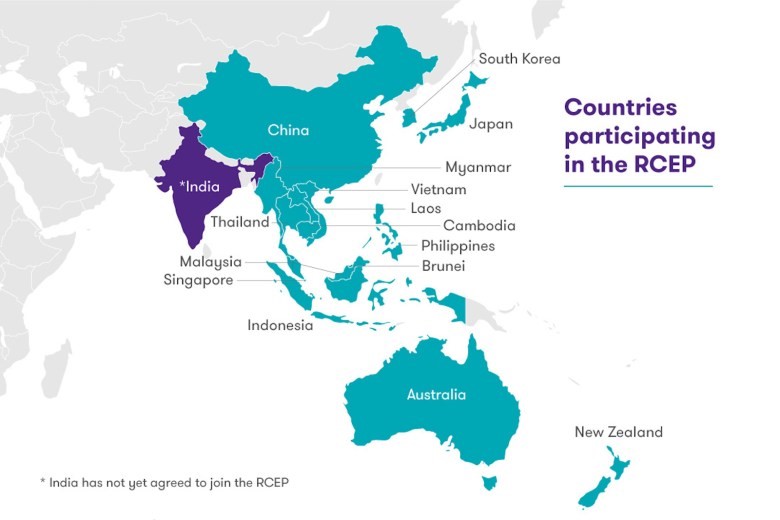Description

Copyright infringement is not intended
Context: Japan still hopes India will re-join RCEP Regional Comprehensive Economic Partnership (RCEP) that it quit in 2019.
Japan views:
- RCEP will benefit the Indian economy with a better supply chain, especially with ASEAN countries.
- India will be treated exceptionally as a founder member and if India is willing to negotiate its re-entry to RCEP.
- India-Japan collaborations may suffer higher tariffs in Asia if India stays out.
What is RCEP?
- The initiative to establish RCEP was taken by the member-states of the Association of Southeast Asian Nations (ASEAN) in 2011.
- Membership: It consists of the 10 ASEAN members and Australia, China, Japan, South Korea and New Zealand.
- The China-backed group is expected to represent at least 30% of the global GDP and will emerge as the largest free trade agreement in the world.
- RCEP negotiations on a framework for investment “to cover the four pillars of promotion, protection, facilitation and liberalization”.
- Purpose:
- to make it easier for products and services of each of these countries to be available across this region.
- to boost commerce among the member-countries spread across the Asia-Pacific region.
India and RCEP:
- RCEP was originally being negotiated between 16 countries — ASEAN members and countries with which they have free trade agreements (FTAs), namely Australia, China, Korea, Japan, New Zealand and India.
- India, after seven years of protracted negotiations decided to exit the grouping.
- Reasons for not joining RCEP:
- protecting indian economy from burgeoning trade deficits with a majority of the 15 RCEP members.
- the final agreement does cover and attempt to address issues that India had flagged including rules of origin, trade in services, movement of persons and, crucially, remedies and safeguards.
- rules of origin— the criteria used to determine the national source of a product — in the absence of which some countries could dump their products by routing them through other countries that enjoyed lower tariffs.
- “inadequate” protections against surges in imports.
- India wanted RCEP to exclude most-favoured nation (MFN) obligations from the investment chapter, especially to countries with which it has border disputes.
- China’s presence:
- Escalating tensions with China
- RCEP is a China-backed grouping.
- to safeguard the interests of industries like agriculture and dairy and to give an advantage to the country’s services sector.
- India has trade deficits with 11 of the 15 RCEP countries.
- The agreement would have forced India to extend benefits given to other countries for sensitive sectors like defence to all RCEP members.
Implications of India not joining RCEP:
- Impact India’s ‘Act East’ strategy, as it an asymmetry in terms of the network of relationship that India is trying to establish.
- It would impact India's bilateral trade ties with RCEP member nations, as they may be more inclined to focus on bolstering economic ties within the bloc.
- It could potentially leave India with less scope to tap the large market that RCEP presents.
- India’s decision could impact the Australia-India-Japan network in the Indo-Pacific.
- It can hinder the works on informal talks to promote a Supply Chain Resilience Initiative among the three.
- High leverage to China as RCEP will give it access to Japanese and South Korean markets, as the three countries have not yet agreed on their FTA
What are India’s options now?
- India, as an original negotiating participant of RCEP, has the option of joining the agreement without having to wait 18 months as stipulated for new members.
- RCEP signatory states that if India submits a request to join the pact “in writing”, it may participate in meetings as an observer prior to its accession.
- India may explore or reviews its existing bilateral FTAs with RCEP members as well as newer markets with potential for Indian exports
- India has taken up the review of the India-Japan CEPA and India-ASEAN FTA with its trading partners.
- India’s interest can be served by investing strongly in negotiating bilateral agreements with the US and the EU, both currently a work in progress.
Conclusion
- Opting out the deal reflects India’s concerns regarding China expansionism and the need to adhere to the rules-based international system.
https://www.thehindu.com/news/international/japan-still-hopes-india-will-re-join-rcep-japan-cabinet-official-noriyuki-shikata/article652438





